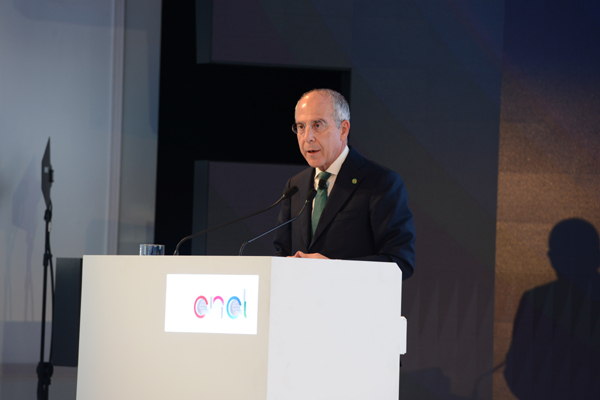Digitalization is turning Enel into an increasingly efficient and proactive operator in the context of the major transformation the entire industry is experiencing. The energy market evolution is opening up opportunities to enhance the Group’s customer proposition through new services. The combination of these two enablers will support the Group in delivering attractive shareholder remuneration and sustainable long-term value creation for all stakeholders.
• Digitalization: 5.3 billion euros investment (a 600 million euro increase vs. the previous plan) to digitalize Enel Group’s asset base, operations and processes and enhance connectivity; targeting 1.9 billion euros cumulative incremental EBITDA contribution between 2018 and 2020 (increasing by 300 million euros vs. the previous plan)
• Customer focus: targeting 3.3 billion euros of EBITDA contribution in 2020, of which 2.9 billion euros relates to power and gas retail and 400 million euros to e-Solutions, leveraging on 67 million end users and almost 35 million power and gas free customers expected in 2020
• Operational efficiency: targeting 1.2 billion euros of savings in real terms in 2020 vs. 2017, of which 500 million euros driven by the investments in digitalization
• Industrial growth: shifting capital allocation towards mature economies mainly in Networks and Renewables; around 80% of growth capex dedicated to Italy, Iberia, North and Central America
• Group simplification & Active portfolio management: continuing the simplification of the ownership structure of the subsidiaries as well as the rationalization of operating companies in South America. Increased focus on minorities buy-out reaching 2.8 billion euros cumulatively between 2017-2020. Share buy-back option still available for up to 2 billion euros until November 2018
• Shareholder remuneration: dividend pay-out confirmed at 70% on Group net ordinary income from 2018 onwards. Minimum dividend of 0.28 euro per share on 2018 results, a 33% increase vs. the minimum dividend guaranteed for 2017.
|
Financial Targets |
|||||
|
2017 |
2018 |
2019 |
2020 |
CAGR (%) 2017-20 |
|
|
Ordinary EBITDA (€bn) |
῀15.5 |
῀16.2 |
῀17.2 |
῀18.2 |
῀+6% |
|
Net ordinary income (€bn) |
῀3.6 |
῀4.1 |
῀4.8 |
῀5.4 |
῀+15% |
|
Minimum dividend per share (€) |
0.21 |
0.28 |
– |
– |
– |
|
Pay-out ratio |
65% |
70% |
70% |
70% |
+5 p.p. |
|
Implicit dividend per share (€) |
0.23 |
0.28 |
0.33 |
0.37 |
῀+17% |
|
FFO/Net Debt |
27% |
27% |
29% |
31% |
῀+4 p.p. |
Francesco Starace, CEO and General Manager of Enel, said: “Since 2015, we have made remarkable progress in all areas of our strategy. Enel is now a much more efficient business with a clearly defined path to industrial growth which, combined with capital discipline and the faster-than-planned execution of asset rotation, has materially increased the Group’s cash generation and profitability. As a consequence, we have been able to raise our 2017 dividend by 44% versus the 2015 pay-out. All these results have been achieved despite significantly more challenging macro scenario conditions than were expected.

This performance has positioned our Group at the forefront of the global energy transition. We are leading in key macro areas for sustainable growth such as renewables and digitalised distribution networks. We can leverage the trends of urbanisation and electrification of demand as well as the resulting profound decarbonisation, to capture the opportunities presented by the major disruption of the entire energy sector. The Group is therefore a more profitable, efficient and sustainable organisation today.
Looking ahead to 2020, digitalisation – introduced last year – has become a concrete and tangible dimension of our business, with increased investment of more than 5 billion euros over the plan. A major focus on customers, including in the new global business line e-Solutions, will provide opportunities for additional value creation.
Our improved financial targets – including the introduction of a minimum dividend per share of 0.28 euro for 2018, a 33% increase on the minimum target for 2017 we presented last year – underpin our confidence in the prospects and role of Enel today and for the years to come.”
London, November 21st, 2017 – Enel Group (hereinafter the “Group”) is today presenting its 2018–2020 Strategic Plan to the financial markets and global media.
The successful execution of the previous 2017-2019 strategic plan has allowed the Group to deliver on each of its key pillars ahead of schedule:
• Operational efficiency – maintenance capex has been reduced by 10% and opex by 1 billion euros in real terms since 2015, mainly through digitalisation;
• Industrial growth – 2017 growth EBITDA target of 800 million euros has already been achieved, including connections, and almost fully addressed 2018 growth EBITDA target;
• Group simplification – the number of companies in South America has been reduced to 53 (from 69 in 2015) and minority economic interest on Group net ordinary income has also been cut back to 27%, from 36% in 2015;
• Active portfolio management – 6.3 billion euros of disposals have been finalized since 2015, ahead of scheduled target to achieve 7.5 billion euros of capital recycling by 2019. Acceleration in the use of funds in 2017: 1.6 billion euros in acquisitions and 500 million euros in minorities buy-out have been finalized;
• Shareholder remuneration – committed to an attractive and growing dividend. Pay-out ratio has increased to 65% in 2017 from 50% in 2015, and dividend per share increased by 44% vs. 2015, reaching 0.23 euro per share in 2017.
This progress against the strategic plan has allowed the Group to maintain all financial guidance for 2017 and exceed the minimum dividend per share guaranteed for the year, despite a more challenging environment than that envisaged in the previous plan.
The sustainability of the strategy is also substantiated by the rapid progress made in terms of the Group’s contribution to the 17 United Nations Sustainable Development Goals (SDGs).
In 2017 the Group delivered on its four public commitments as follows:
‐ exceeded the goal set for 2020 in terms of beneficiaries to enjoy high quality, inclusive and fair education, reaching around 500,000 people (SDG 4);
‐ made considerable progress in delivering access to affordable and clean energy, reaching 1.7 million people (SDG 7);
‐ achieved the goal set for 2020 in terms of employment, and sustainable and inclusive economic growth, set at 1.5 million people (SDG 8);
‐ progressed on the pathway to a zero-emission generation portfolio despite a year characterized by very poor hydro conditions across all the Group’s geographies, reaching 399 gCO2/KWheq (SDG 13).
THE NEW PLAN: 2018 – 2020 STRATEGIC PILLARS
The pillars of the Group’s strategic plan remain in place with further evolution and acceleration in their implementation.
Digitalization and Customer focus, introduced last year, continue to be major enablers of the strategy. The Group’s focus on customers is benefitting from increased momentum thanks to the introduction of the new Global Business Line e-Solutions.
The Group retains the operational efficiency and industrial growth pillars. Since Group simplification has become a recurring element of the business model and now overlaps significantly with Active portfolio management, these two pillars have been merged.
Human capital supplements the purely industrial pillars by fostering the economic and social growth of local communities and enhancing the roles and skills of people within the organization, empowering them to manage the energy transition.
The strategic plan is designed to further enhance the Group’s delivery of attractive shareholder remuneration and sustainable long-term value creation for all stakeholders.
On the enablers, the Group plans the following strategic actions:
1. DIGITALISATION
Digitalization capex increases to 5.3 billion euros vs. 4.7 billion euros envisaged in the previous plan, and is expected to generate 1.9 billion euros of cumulative incremental EBITDA between 2018-2020, or 900 million euros of incremental EBITDA in 2020. Around 60% of this growth will come from higher margins and 40% from lower opex on a cumulative basis, implying strong double-digit returns from this investment. The expected 1.9 billion euros of cumulative incremental EBITDA contribution represents an increase of 300 million euros vs. the previous plan.
2. CUSTOMER FOCUS
The Group is targeting a total of 3.3 billion euros of EBITDA in 2020, representing a 32% increase vs. 2017.
In the power and gas retail business, the Group is expected to deliver 21% EBITDA growth, reaching 2.9 billion euros in 2020, up from 2.4 billion euros in 2017, while increasing overall volumes sold by more than 30%.
Specifically, commodity retail EBITDA growth is expected to stem mainly from:
• a 33% increase in volumes in the free power market, mainly in Europe;
• stable power unitary margins in the free market;
• a 30% reduction in the overall cost-to-serve¹.
In e-Solutions, which is expected to contribute the remaining 400 million euros on EBITDA in 2020, four product/service lines have been set up to address new customer needs stemming from the transition from a centralized to a distributed energy model:
– e-Industry: offering solutions to large commercial and industrial clients with a specific focus on “flexibility” services;
– e-Mobility: covering all customers segments, from residential to industrial and public, with the aim of being a technology leader in the sector;
– e-Home: offering solutions to residential customers, such as installation, maintenance and repair of advanced home energy appliances;
– e-City: offering integrated energy services to the public administration and municipalities as well as connectivity services, such as fibre optic wholesale services.
The e-Solutions business line will be coming to market in 2018 under a new brand, Enel X.
On the strategic pillars, the Group plans the following:
1. OPERATIONAL EFFICIENCY
Enhanced digitalization is expected to allow the Group to achieve a cash cost target of 10.3 billion euros in 2020 vs. a 2017 cash cost base of 11.1 billion euros, or a 7% reduction in nominal terms.
The cash cost target will be the result of:
• a 20% reduction in maintenance capex to 2.0 billion euros in 2020 vs. 2.5 billion euros in 2017, net of network connections and despite asset base growth;
• a 3% reduction in opex to 8.3 billion euros in 2020 vs. 8.6 billion euros in 2017 in nominal terms, equivalent to a reduction of 1.2 billion euros in real terms², of which 500 million euros are derived from investments in digitalization.
2. INDUSTRIAL GROWTH
The Group forecasts a total capex spend of 24.6 billion euros between 2018 and 2020, increasing by 500 million euros vs. the previous plan and including 3.4 billion euros of capex under the build, sell and operate (“BSO”) model. The Group expects a 30%-70% mix between maintenance and growth capex for the period, a further improvement vs. the previous plan.
The asset digitalization plan will drive an additional increase in investments in Networks and Retail through e-Solutions, primarily in smart meters, remote-control and connectivity of equipment, as well as investments in digitalizing customer engagement and promoting a more digitally-oriented workforce. These investments will allow the Group to keep maintenance capex stable, reduce opex and free up additional resources for growth.
The growth capex plan is now 80% devoted to maturing markets, representing a significant change from the 60% under the previous plan, with the effect of further reducing its risk profile. From a geographical standpoint the allocation of capex vs. the previous plan evolves as follows:
– 40% increase in North & Central America, driven by Renewables growth;
– 23% increase in capex in Italy, driven by Networks;
– 35% increase in capex in Iberia, driven by Networks and the restart of Renewables growth;
– 26% lower capex in South America, mainly in Renewables.
Almost 95% of Group growth capex will be invested in non-merchant risk businesses, such as Networks, Renewables and Thermal Generation covered by Power Purchase Agreements (PPAs).
The Group expects to generate 3.6 billion euros of cumulative growth EBITDA over the 2018-2020 period, excluding the contribution from connections. The increase will be driven by investment in:
– Networks: growth capex expected to reach around 4.7 billion euros cumulatively over the 3 years, mostly on asset digitalization. The number of installed smart meters is expected to increase to 47.9 million, of which 17.4 million are second-generation meters. End users are expected to increase by 2 million to 67 million in 2020 from the current level of 65 million;
– Renewables: total growth capex of 8.3 billion euros planned, which is expected to deliver 7.8 GW of total additional capacity over the 3 years. Of this, 3.4 billion euros will be invested under the BSO model, resulting in 3.8 GW of additional capacity; the remaining 4.0 GW of new capacity will be delivered organically.
– e-Solutions: 800 million euros of cumulative growth capex over the 3 years, mainly in the installation of charging stations, software platforms and public lighting.
3. GROUP SIMPLIFICATION & ACTIVE PORTFOLIO MANAGEMENT
Over the next three years, the Group plans to dispose of a further 3.2 billion euros of existing assets mainly focusing on Thermal Generation and exiting non-strategic countries, as well as investing up to 4.7 billion euros in:
• 2.3 billion euros in the buy-out of minorities;
• 2 billion euros in acquisitions in the Networks and e-Solutions businesses;
• the remaining 400 million euros in equity partnerships.
The planned allocation of funds to the buy-out of minorities has increased by 300 million euros to 2.3 billion euros between 2018 – 2020 vs. the previous plan. Taking into account the 500 million euros already executed in 2017, the overall minorities reinvestment target is for a total of 2.8 billion euros over the 2017-2020 period.
In line with the previous plan, the Group’s priority remains focused on the buy-out of minorities in South America. However, the Group still retains the flexibility to execute a share buy-back of up to 2 billion euros, following the authorization, valid until November 2018, granted by Enel’s 2017 AGM.
Furthermore, Enel expects to continue to reduce the number of operating companies in South America, reaching less than 30 operating companies in the region by 2020, compared with 53 companies at the end of 2017. Over the plan’s period, the Group also expects to further simplify the ownership structure of the subsidiaries of Enel Americas, Enel Romania and Enel Investment Holding.
Simplification remains an ongoing process, with the objective of increasing the Group’s consistency, focus and efficiency.
4. SHAREHOLDER REMUNERATION
The dividend policy of a 70% pay-out ratio for 2018 and 2019 is confirmed, with the introduction of the same pay-out ratio for 2020, all applied to Group net ordinary income.
In addition, for 2018 a minimum dividend per share of 0.28 euro has been introduced. Therefore, on 2018 results Enel is expected to pay the higher of:
a) a dividend of 0.28 euro per share;
b) a dividend per share based on the aforementioned 70% pay-out ratio.
5. SUSTAINABLE LONG-TERM VALUE CREATION
The strategic plan clearly shows the deployment, across the board of the 17 United Nations Sustainable Development Goals, of the Group’s sustainable business model throughout the value chain.
In terms of targets, the Group confirms and accelerates its specific commitment, undertaken in September 2015, on the following Sustainable Development Goals:
‐ 800,000 beneficiaries of quality education by 2020, up twofold from the previous 400,000 (SDG 4);
‐ 3 million beneficiaries of access to affordable and clean energy by 2020, mainly in Africa, Asia and South America (SDG 7);
‐ 3 million beneficiaries of employment and sustainable and inclusive economic growth by 2020, up twofold from the previous 1.5 million (SDG 8);
‐ On climate action: <350gCO2/KWheq by 2020 (SDG 13).
¹ The unitary cost per client.
² Reduction in real terms is net of the impact on opex from consumer price index (CPI) & forex (approx. 400 million euros), growth (approx. 300 million euros) and M&A (approx. 100 million euros).



